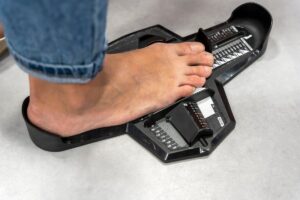Many individuals encounter daily challenges with wide feet, yet finding the ideal footwear can be a seamless experience. Common concerns such as discomfort, blisters, and a restricted selection of shoes often arise. However, understanding your feet’s specific requirements can greatly enhance your shopping experience. Wearing improperly fitting shoes can lead to serious foot complications, including bunions and chronic pain. Acknowledging that wide feet are a natural variation is the first step toward comfort, and selecting the right footwear can prevent long-term health issues. This comprehensive guide aims to deepen your understanding of wide feet and help you discover shoes that balance both comfort and style.
Understand the Unique Features of Wide Feet for Better Choices
Gaining insight into your wide feet is crucial for making wise footwear decisions. Studies show that nearly 30% of adults have feet that are wider than standard shoe sizes. Factors that can affect foot width include genetics, age, and lifestyle habits. By identifying these influences, you can choose shoes tailored specifically to your unique foot shape, ensuring a more comfortable fit.
Celebrate Natural Variations in Foot Size and Structure
Foot width, like height and body shape, varies naturally among individuals. Your genetic background plays a significant role in determining your foot structure. If you’ve inherited wide feet from your family, remember that this trait is common and not a medical concern. Recognizing these genetic aspects enables you to embrace your foot characteristics and make informed footwear selections that enhance your overall comfort.
Be Aware of Changes in Foot Width Throughout Life
Various life events can lead to changes in foot width over time. Pregnancy can increase foot width by as much as one full size, and as you age or experience weight fluctuations, you may notice differences in your foot size. Additionally, prolonged periods of standing or certain medical conditions can contribute to widening.
Understanding these changes is crucial for adapting your footwear choices accordingly. Regular foot measurements are advisable, as your size can shift every few years. Factors such as weight changes, aging, and physical activity impact these variations. Neglecting to adjust your shoes to these changes can lead to foot problems, including bunions, corns, and ongoing discomfort.
Investigate the Common Factors Leading to Wide Feet
Understanding the underlying reasons for your wider-than-normal feet is essential. Multiple factors can contribute to wide feet, including genetics, medical conditions, and lifestyle choices. Identifying these elements allows you to pinpoint potential solutions tailored to your individual needs and preferences.
Explore the Genetic Factors Impacting Foot Width
Your family history and inherited foot structure are critical in determining your foot width from birth. Characteristics like bone structure and arch type are passed down through generations, shaping the development of your feet. By comprehending these inherited traits, you can gain valuable insights into your feet’s unique shape and make more educated choices about your footwear.
Identify Health Conditions That Can Influence Foot Width
Sometimes, underlying health conditions can lead to widened feet. Common issues such as diabetes, arthritis, and edema can affect both the shape and size of your feet.
The impact of these medical conditions on foot width can vary; changes might be temporary or permanent. For example, your feet may swell during pregnancy, after an injury, or due to circulation issues. Regular check-ups with your healthcare provider can help you keep track of any changes and tackle potential problems early on.
Analyze Lifestyle Elements Affecting Foot Width
Experts agree that your daily habits can have a significant impact on your foot width. Extended periods of standing, excessive weight, and ill-fitting footwear can gradually result in wider feet over time.
The combination of your lifestyle with genetic and environmental factors dictates your foot width. High-impact activities and poor shoe selections can accelerate these changes. The nature of your job and daily activities plays a vital role in your foot health and overall shape.

Recognize the Health Risks Associated with Wide Feet
If not properly accommodated, wide feet can lead to serious health issues compared to standard feet. The width of your feet affects the alignment of your entire body and can impact your joints, posture, and overall mobility. Studies indicate that a staggering 72% of people do not wear shoes that fit their width correctly, often resulting in preventable foot ailments.
Grasp the Physical Impact of Wide Feet on Your Well-Being
Approximately 65% of individuals with untreated wide feet report experiencing chronic foot pain. When your foot support is inadequate, your body compensates by altering your gait, leading to knee pain, hip discomfort, and lower back issues. Over time, these compensatory adjustments can result in lasting joint problems if you do not wear properly fitting shoes.
Confront Daily Discomfort Due to Ill-Fitting Shoes
When your footwear is ill-suited for your wide feet, everyday tasks can become challenging. You may encounter immediate discomfort, blisters, and pressure points that restrict your ability to move comfortably. Research suggests that 80% of individuals with wide feet report decreased activity levels due to foot discomfort.
The ramifications of wearing the wrong shoes extend beyond temporary pain. Your feet may develop painful conditions such as bunions, corns, and calluses, which can negatively impact your balance and stability, making you more susceptible to falls and injuries. Selecting the right footwear is essential for preserving your foot health and overall well-being.
Find the Best Footwear Solutions for Comfort and Support
Discovering the right footwear is vital for individuals with wide feet, ensuring both comfort and promoting foot health. Your shoes should not only provide ample space but also offer the necessary support and stability for your daily activities.
The Importance of Accurate Foot Measurement for Proper Fitting
Getting precise foot measurements is essential for selecting shoes that fit comfortably. Measure your feet at the end of the day when they are at their largest, and remember to measure both feet, as sizes may vary between them.
Discover the Ideal Shoe Types Designed for Wide Feet
To effectively accommodate wide feet, certain styles of shoes are more suitable than others.
| Feature | Benefit |
|---|---|
| Wide toe box | Allows for natural toe spread |
| Adjustable closures | Enables a customizable fit |
| Breathable materials | Helps reduce swelling |
| Deep heel cup | Provides enhanced stability |
| Flexible sole | Adapts to your foot shape |
- Athletic shoes featuring breathable mesh uppers
- Sandals designed with adjustable straps
- Loafers available in wide widths
- Boots crafted with stretch panels for added comfort
For instance, specific shoe designs can greatly enhance your overall comfort levels.
| Shoe Type | Best Features |
|---|---|
| Running shoes | Offer extra width options |
| Walking shoes | Provide a roomy toe area |
| Casual shoes | Made with stretchable materials |
| Dress shoes | Available in multiple width options |
| Work boots | Designed with wide-fit profiles |
Essential Strategies for Shopping for Wide Feet
Your success in finding comfortable shoes for wide feet relies on thoughtful planning and informed choices. Look for specialty stores that offer wide-width options and have knowledgeable staff to assist with proper measurements. It’s advisable to shop during the afternoon when your feet are naturally at their widest to ensure the best fit.
Selecting the Right Brands Known for Wide Width Options
To discover the right footwear, prioritize brands recognized for their wide-width offerings, such as New Balance, Brooks, and ASICS. These brands specialize in creating shoes with added room in both the toe box and midfoot area, ensuring enhanced comfort for individuals with wide feet. Focusing on quality construction and proper support is vital for your long-term satisfaction and comfort during wear.

Expert Tips for Achieving the Perfect Fit
Successful shoe purchases rely heavily on effective fitting techniques. Adhere to these important guidelines:
- Measure both feet while standing
- Ensure you have a thumb-width space at the toe area
- Try shoes on with your usual socks
- Test the shoes by walking around in them
- Shop during the late afternoon
Feeling immediate comfort is essential for making the right choice.
Fitting procedures require attention to detail and patience. Consider these additional factors:
- Check for proper arch support
- Ensure there are no pressure points on your feet
- Verify the stability of the heel
- Test for flexibility at the ball of the foot
- Explore various lacing techniques to customize fit
Paying attention to these details will help you find the perfect fit for your wide feet.
Essential Care Practices for Maintaining Footwear
Proper care for your wide feet requires regular attention to maintain foot health and prolong the life of your shoes. Incorporate consistent cleaning and drying of both shoes and feet into your daily routine to prevent issues such as fungal infections and unpleasant odors. Regular upkeep can reduce foot pain by as much as 40% and extend the lifespan of your footwear significantly.
Daily Routines to Enhance Foot Health
Beneficial practices for your wide feet include rotating between different pairs of shoes to allow for adequate drying time and minimize excessive wear. After each use, wipe your shoes clean and consider using shoe trees to maintain their shape. Implementing these straightforward steps can extend the lifespan of your shoes by up to 2 years and provide better support for your feet.
Long-Term Strategies for Preventing Foot Health Issues
Consistent care for your wide feet requires ongoing attention to prevent future complications. It’s advisable to replace your shoes every 400-500 miles of walking or whenever you notice significant wear patterns. Regularly measuring your feet is also essential, as your foot width can change over time.
While caring for your footwear, prioritize foot exercises and stretches. Engaging in regular foot exercises can enhance flexibility by 30% and alleviate discomfort. Ensure that your feet receive proper circulation by avoiding prolonged sitting, and consider using compression socks if you need to stand for long periods.
Reflecting on your journey to find the ideal footwear for wide feet can be straightforward with the right knowledge. By understanding your foot width, selecting brands that cater to wide sizes, and employing effective measurement techniques, you can make better shoe choices. Your comfort is paramount, so invest time in trying on various shoes to ensure they provide ample space for your feet. Following these tips and being mindful of how your shoes fit will guide you towards footwear that supports your daily activities while keeping your feet healthy and pain-free.
Addressing Common Questions About Wide Feet
What’s the best method to measure my feet for suitable wide-width shoes?
Stand on a piece of paper while wearing your usual socks. Trace both feet and measure their length and width at the widest points. It’s best to do this in the evening when your feet are at their largest. Compare these measurements to standard shoe size charts and select shoes that correspond to the measurements of your larger foot. Always test new shoes by walking around in them for several minutes to evaluate comfort.
Which shoe features are essential for individuals with wide feet?
Look for shoes that have a wide toe box, allowing your toes to spread comfortably. Seek shoes labeled with “W” for wide or “EE” width. Opt for materials like soft leather or breathable mesh that stretch and conform to your foot shape. Choose footwear with adjustable features, such as laces or straps, and avoid pointed toe designs in favor of rounded or square toe shapes.
How can I prevent foot problems resulting from incorrect shoe sizes?
Replace any footwear that exhibits signs of significant wear. Purchase shoes from brands that specialize in wide-width options. Ensure that your toes have enough space to move easily. If necessary, consider using shoe inserts for added support, and alternate between different pairs of shoes daily. Check your foot size annually, as feet can change, and discontinue wearing shoes that cause pain or discomfort.
The Article The Ultimate Wide Feet Guide: Concerns, Footwear Tips, and More appeared first on My Shoes Finder
The Article Wide Feet Guide: Essential Tips and Footwear Solutions Was Found On https://limitsofstrategy.com


